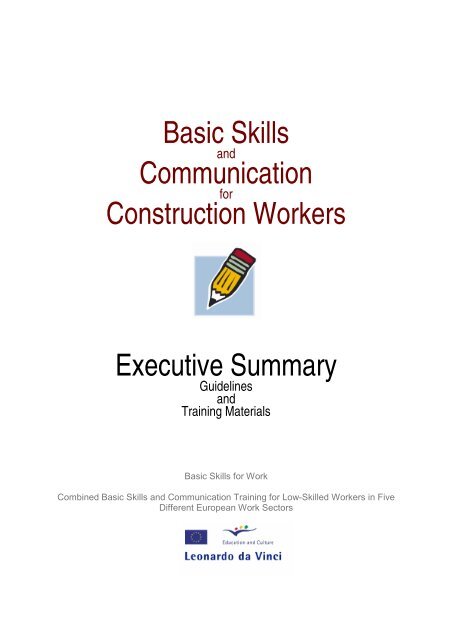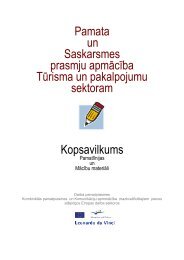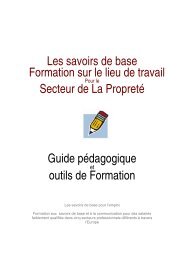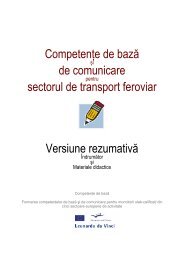Basic Skills Communication Construction Workers Executive Summary
Basic Skills Communication Construction Workers Executive Summary
Basic Skills Communication Construction Workers Executive Summary
Create successful ePaper yourself
Turn your PDF publications into a flip-book with our unique Google optimized e-Paper software.
<strong>Basic</strong> <strong>Skills</strong><br />
and<br />
<strong>Communication</strong><br />
for<br />
<strong>Construction</strong> <strong>Workers</strong><br />
<strong>Executive</strong> <strong>Summary</strong><br />
Guidelines<br />
and<br />
Training Materials<br />
<strong>Basic</strong> <strong>Skills</strong> for Work<br />
Combined <strong>Basic</strong> <strong>Skills</strong> and <strong>Communication</strong> Training for Low-Skilled <strong>Workers</strong> in Five<br />
Different European Work Sectors
BASIC SKILLS FOR WORK<br />
In the past years, the issue of “<strong>Basic</strong> <strong>Skills</strong>” has gained particular attention in most European countries. Of particular<br />
concern are what is generally called ‘functional literacy’ and ‘functional numeracy’ defined as “the ability to read,<br />
write and speak in the respective language and to use mathematics at a level necessary to function at work and in<br />
society in general”.<br />
This Curriculum has mainly been designed for adult education providers, trainers and teachers. It consists of different<br />
modules, the main chapters dealing with information on the target group, literacy, numeracy and social skills, that allow<br />
for flexible utilisation according to various specific requirements.<br />
The main objective is to empower employees with improved basic skills in both numeracy and literacy (numbers,<br />
measures, calculations, reading comprehension, short writing tasks). The Curriculum also focuses, on important social<br />
and communication skills particularly required in this profession.<br />
LITERACY: DIDACTIC BACKGROUND<br />
Learning contents and purpose<br />
Reading and understanding signs and symbols: Focus on health and safety issues!<br />
1 Inform learners about different types of signs and symbols that are important when working in the<br />
construction area (prohibition signs, mandatory signs, warning signs, safe condition signs, fire equipment<br />
signs) to enable them to differentiate<br />
2 Enable learners to associate signs and symbols with specific and correct meanings<br />
3 Enable learners to convey respective messages to their colleagues or other people possibly involved<br />
(clients, representatives of other companies, suppliers, passers-by etc.)<br />
4 Respective contents should always be related to the actual workplace of your learners (when choosing<br />
examples, always consider the context of learners’ everyday work experience)<br />
5 Dealing with signs and symbols relevant for the construction area, generally increase your learners’<br />
awareness of health and safety issues<br />
Starting out on a basic literacy level (alphabet, alphabetical order): Focus on relation to workplace surroundings!<br />
As for writing skills, it is important to consider that a high number of workers in the construction area are of East<br />
European origin and are partly used to different alphabets and scripts. It is therefore necessary to start work on literacy<br />
training on a very basic (entry) level.<br />
Consider the following:<br />
• Practical relevance and closeness to actual experience of all materials used and all examples given<br />
(e.g. tool about alphabetical order: names should be the actual names of the working team involved)<br />
• To make learning contents relevant for students and demonstrate their actual employability: focus on<br />
workplace related contents (e.g. the vocabulary being taught and dealt with during training: it is most important<br />
for the learners to be confronted with terms denoting concrete items of their work, such as work tools,<br />
machines etc.)<br />
2
<strong>Basic</strong> writing exercises: Focus on relevance for everyday life!<br />
Practical exercises concentrate, among others, on how to fill in forms, keep lists and maintain accurate, legible and<br />
complete records.<br />
Consider the following:<br />
• Use authentic materials, i.e., for example, forms that learners will actually come across in their everyday life<br />
(forms used at certain offices, registrations, CV forms of actual companies etc.) to demonstrate relevance of<br />
learning contents<br />
• Ask and motivate your learners to bring their own sample forms<br />
• Exercises of how to fill in forms can always be made use of as a basis for joint exchange of experience,<br />
constructive reflection on learners’ skills, strengths and weaknesses, discussion on past success and failure,<br />
future perspectives etc. Hence these basic writing exercises can be a starting point for communicative training<br />
units (combination with social skills training) in which learners practice how to effectively pass on information<br />
to each other<br />
• Exercises (e.g. filling in CV forms) can be written preparation work for various role plays acted out in class<br />
(like job interviews etc.), i.e. intensive training of social skills<br />
Reading exercises: Focus on filtering important information related to workplace surroundings!<br />
Reading comprehension includes exercises and classroom activities dealing with how to obtain information from<br />
instructions and/or catalogues (e.g. of manufacturers). Learners will train, for instance, understanding and checking<br />
delivery notes, as well as passing on related messages to colleagues. There can also be practise on reading texts and<br />
notices about safety (e.g. safe lifting), handling and storage procedures. Various manuals can be carefully read and<br />
summarised to colleagues and fellow learners.<br />
Consider the following:<br />
1 Take examples from actual work life (catalogues etc.)<br />
2 Always point out and demonstrate the relevance and usefulness of reading practice to your learners (how<br />
to make things easier for them in everyday job life)<br />
3 In order to achieve efficiency and ideal learning results and to provide for change in a sufficient way:<br />
a. again and again combine reading and writing activities in class<br />
b. Often motivate your learners to compare results, i.e. at the same time carry out communication<br />
training and reflection work (see sample methods and tools below)<br />
Learning materials for literacy<br />
The following exercises can be found in the part 2 of this Curriculum (Toolbox). They cover the following sectors:<br />
Signs and Symbols, Alphabetical order, Filling in forms, Filtering important information, Understanding information<br />
3
NUMERACY<br />
Learning contents and purpose<br />
Focus on relation to workplace surroundings and relevance for everyday work!<br />
In order to empower employees with improved basic skills in numeracy, methods and tools in a course for construction<br />
workers shall primarily be related to tasks and duties included in actual jobs in this work area. Since it is, for example,<br />
of crucial importance to be able to mix materials correctly, learners shall be confronted with different exercises on<br />
volumes and measurements and be trained how to work out ratio and direct proportion. One of the aims of such<br />
trainings shall be to increase the learners’ awareness and knowledge of how to use mathematical information and<br />
language and how to identify suitable calculations to achieve an appropriate outcome (this is, for instance, important for<br />
doing or completing a materials list).<br />
The exercises attached are dealing with the following aspects:<br />
1 <strong>Basic</strong> numeracy skills, using mathematical information<br />
2 Using the basic arithmetical operations<br />
3 Practising common measures<br />
4 Practising common measures by converting<br />
5 Working out metric units of lengths<br />
6 Working out perimeter and area<br />
7 Working out ratio<br />
Other major elements of basic skills training for construction workers are:<br />
• Shape and space<br />
• Dealing with whole numbers<br />
• Negative numbers<br />
• Fractions<br />
• Decimal measures<br />
• Everyday percentages<br />
• How to work out metric units of width<br />
• <strong>Basic</strong> numeracy, arithmetic, calculation skills (e.g. for working out correct amounts of materials)<br />
Consider the following:<br />
1. Provide for an overall brush-up of basic mathematics (explanation and demonstration) and make sure<br />
each individual student understands contents (adding, subtracting, multiplying, dividing etc.)<br />
2. No pressure, provide enough time for students to do respective exercises<br />
4
3. Practical relevance and closeness to actual experience of all learning materials used and all examples<br />
given (e.g. exercise on doubling amounts, take cement or sand as an example)<br />
4. To make learning contents relevant for students and demonstrate their actual employability: focus on<br />
workplace related contents (see methods and sample tools below)<br />
5. Use authentic materials, i.e., for example, forms that learners will actually come across in their everyday<br />
job life (forms used at certain companies etc.) to demonstrate relevance of learning contents<br />
6. Ask and motivate your learners to bring their own sample forms<br />
7. Exercises can always be made use of as a basis for joint exchange of experience, constructive reflection<br />
on learners’ skills, strengths and weaknesses, discussion on past success and failure, future perspectives<br />
etc.<br />
8. Hence these basic numeracy exercises can be a starting point for communicative training units<br />
(combination with social skills training) in which learners practice how to effectively pass on<br />
information to each other.<br />
9. Exercises can be written preparation work for various role plays acted out in class i.e. intensive practical<br />
social skills training<br />
10. The exercises are to be done individually as a comprehension check. Compare the results in class.<br />
Learning materials for numeracy<br />
The following exercises can be found in the part 2 of this Curriculum (Toolbox). They cover the following areas:<br />
1 <strong>Basic</strong> numeracy skills, using mathematical information<br />
2 Using the basic arithmetical operations<br />
3 Practising common measures<br />
4 Practising common measures by converting<br />
5 Working out metric units of lengths<br />
6 Working out perimeter and area<br />
7 Working out areas for walls<br />
8 Working out ratio<br />
5
COMMUNICATION SKILLS<br />
Learning contents and purpose<br />
Focus on the relevance for everyday working life!<br />
In order to empower learners within a basic skills course for construction workers with relevant social and<br />
communication skills, there shall be particular emphasis on reflection on communicative behaviour and different<br />
aspects of conflict management. Group work (role plays, imitation of job situations etc.) shall concentrate on both<br />
speaking skills (how to express oneself, respond properly, give relevant information to colleagues, superiors, employers,<br />
representatives of other companies etc.) and listening comprehension (understanding simple explanations and<br />
instruction in order to be able to carry out duties).<br />
Major elements of social skills training for construction workers shall, in addition, be the following:<br />
• Team building<br />
• Team awareness<br />
• Team spirit<br />
• Social responsibility of the individual within a group of working colleagues<br />
• Cooperation among colleagues/fellow students<br />
• Improvement of mutual assistance<br />
Consider the following:<br />
1. Provide for an overall positive atmosphere of openness and trust and make sure each individual student<br />
feels comfortable and free to work on reflection and communication<br />
2. No pressure, provide enough time for students to communicate<br />
3. Make your students aware of the fact that effective spoken communication is essential in construction<br />
work and that passing on information clearly is essential to everyone's safety and successful work outputs<br />
in your team.<br />
4. Therefore focus on conveying the following principles:<br />
a. always speak clearly<br />
b. report things quickly but also carefully and always in an understandable way<br />
c. keep to the facts<br />
d. remember to report all necessary facts<br />
e. keep facts in order<br />
5. Always refer to practical relevance and closeness to actual experience of all learning materials used and all<br />
examples given:<br />
6. To make learning contents relevant for students and demonstrate their actual employability: focus on<br />
workplace related contents (see methods and sample tools below)<br />
6
7. In order to demonstrate relevance of learning contents: Use authentic materials dealing with contents learners<br />
will actually come across in their everyday job life<br />
8. Ask and motivate your learners to bring their own materials and examples<br />
Raise your learners’ awareness of different roles and functions within a team:<br />
• Who does what at a building site<br />
• Who takes which responsibility<br />
• How do we all act as a team<br />
• Who has working relationships with whom<br />
• Who gives orders and who receives them<br />
• Are the roles organised on the same levels or not<br />
When practising to describe images and listen to descriptions, focus on:<br />
• learners’ ability to catch distance, proportion and similarity relationships<br />
• their ability to adopt the viewpoint of others<br />
• learners’ ability to represent with accuracy the verbal description of others<br />
Exercises can always be made use of as a basis for joint exchange of experience, constructive reflection on learners’<br />
skills, strengths and weaknesses, discussion on past success and failure, future perspectives etc.<br />
Exercises can be written preparation work for various role plays acted out in class, i.e. intensive practical social skills<br />
training<br />
Learning materials for communication skills<br />
The following exercises can be found in the part 2 of this Curriculum (Toolbox). They cover the following areas:<br />
1. Team building and team awareness<br />
2. Team spirit<br />
3. Cooperation among colleagues<br />
4. Improvement of mutual assistance<br />
7
© 2006 BEST Institut für berufsbezogene Weiterbildung und Personaltraining, Vienna, Austria<br />
Print: Plankopie Eder, Vienna, Austria<br />
This publication was developed in the course of the LEONARDO DA VINCI pilot project<br />
“<strong>Basic</strong> <strong>Skills</strong> for Work - Combined <strong>Basic</strong> <strong>Skills</strong> and <strong>Communication</strong> Training for Low-Skilled <strong>Workers</strong><br />
in Five Different European Work Sectors”<br />
This project has been funded with support from by the LEONARDO DA VINCI programme of the<br />
European Commission. This publication reflects the views only of the authors, and the Commission<br />
cannot beheld responsible for any use which may be made of the information contained herein.<br />
Project number: A/04/B/F/PP-158.132<br />
For non-commercial purposes, a download version of this publication is available at least until<br />
30 September 2009 at the project homepage:<br />
http://www.basic-skills-for-work.org<br />
8






